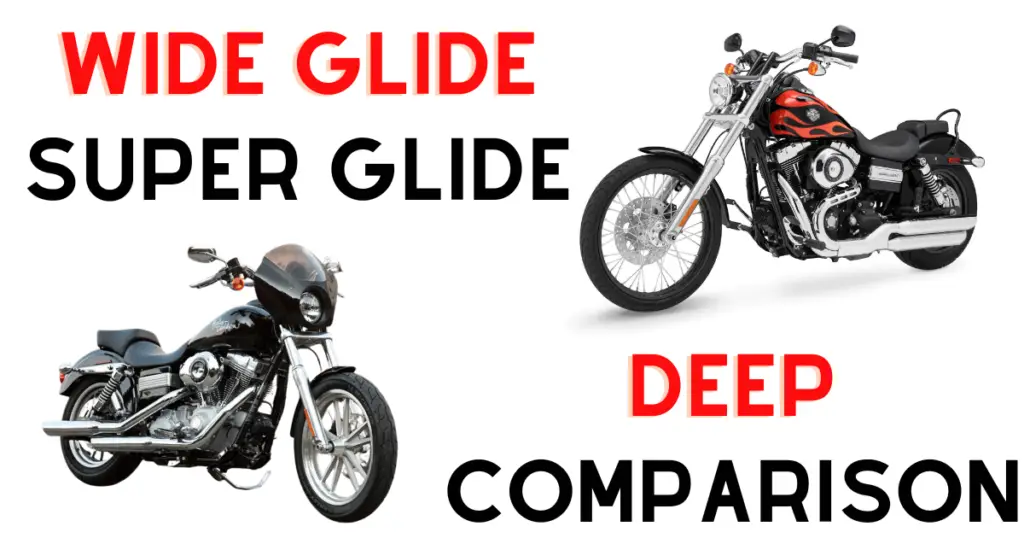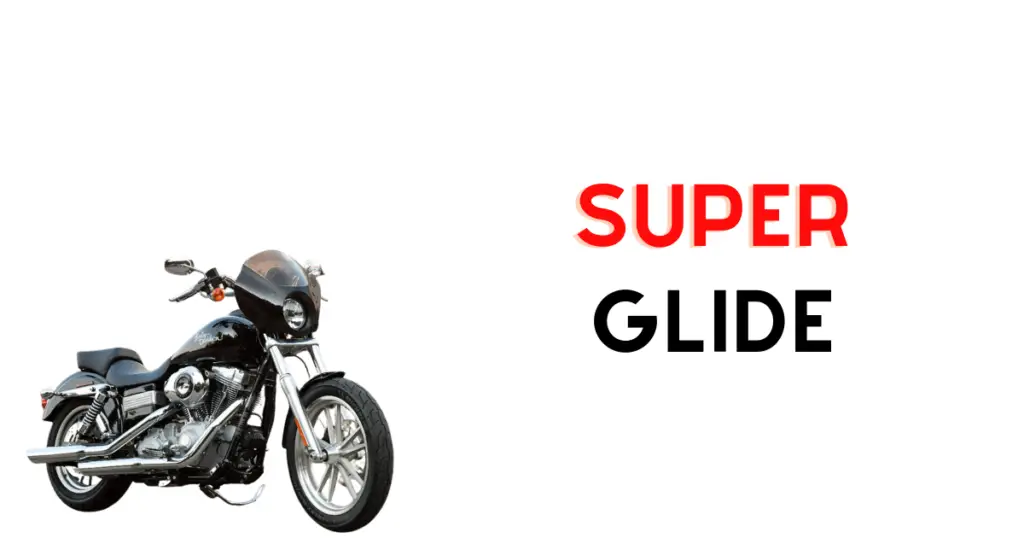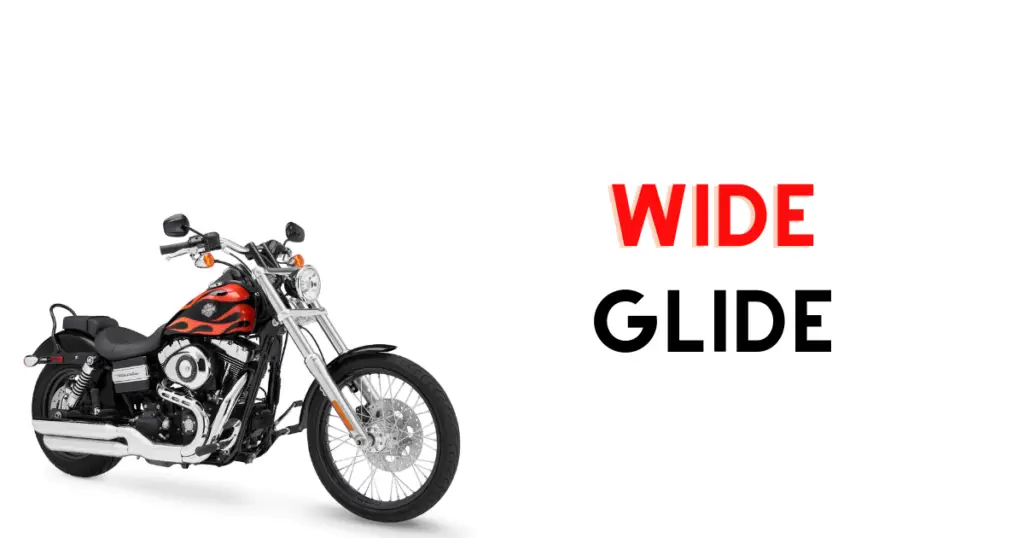With a clashing crescendo of horsepower and aesthetic appeal, both the Super Glide and Wide Glide have set their rods firmly in the landscape of iconic motorcycles. But what sets them apart from one another? You may ask. Well, it’s a road often traveled but rarely explored in detail.
As rumbling engines spark your curiosity, this guide dives into the intriguing world of ‘Super Glide vs Wide Glide’. As shifting shadows on the open road, these two titans embody different philosophies in design and performance. Yet, they share the common highway of desirability, igniting the debate further.
Hop on and join us as we throttle through the veil of the unknown, exploring their distinctive features and finding out what truly makes each one a roaring legend!
Related read: I Found The Best Harley For Tall Riders (No, Really)
Breakdown: What Makes a Wide Glide and Super Glide?

The Harley Davidson Super Glide and Wide Glide are not just motorcycles; they are chapters in the storied history of an iconic brand. The Super Glide, introduced in 1971, marked the beginning of the FX series, blending the Sportster’s agility with the Electra Glide’s power. The Wide Glide, debuting in 1993, brought a chopper-like aesthetic to the Dyna family, with its wide, raked fork and beefy profile. This section delves into their evolution, tracing the journey from their inception to the modern-day marvels they have become.
Read next:
– Harley Model Showdown: FXR vs FXRS vs FXRT
– Dyna vs FXR: Historic Harley Model Showdown and Comparison
Harley Davidson Super Glide

The Harley Dyna Super Glide, first introduced in 1971, marked the birth of the Harley Davidson FX series. This bike was a combination of the Electra Glide’s frame and rear suspension with the Sportster model’s telescopic forks and wheels. Over the years, the Super Glide evolved, with multiple FX models introduced and older features being reintroduced. The Super Glide’s distinctive features include its “Factory Experimental” label, represented by the term FX, and its narrow front end.
Harley Davidson Wide Glide

The Harley Dyna Wide Glide, on the other hand, was launched in 1993. It’s considered one of the most stylish Dyna Glide models, boasting a chopper-like look and a beefy, low profile. Its defining feature is its wide, raked fork, which is where it got its name. The Wide Glide is well-known for its performance on freeways and winding country roads, providing a comfortable and fun ride for its users.
Related article:
– What Year Harleys To Avoid
– Dyna Wide Glide Problems: Common Issues and Solutions
Overview of Specifications Table for Both Models
| Feature | Super Glide | Wide Glide |
|---|---|---|
| Engine | Twin Cam 96 | Twin Cam 103 |
| Power | Moderate, suited for city riding | Higher torque, suited for open roads |
| Handling | Agile and maneuverable | Stable but less agile |
| Design | Classic Harley cruiser style | Chopper-inspired aesthetic |
| Seat Height | Lower, comfortable for shorter riders | Higher, ideal for taller riders |
| Customization | Moderate customization options | Extensive customization potential |
| Ride Quality | Smooth, suitable for urban areas | Comfortable, ideal for long distances |
| Control Placement | Mid-controls | Forward controls |
| Price Range | Generally more affordable | Slightly higher price point |
| Best For | Urban commuting, versatility | Long rides, chopper enthusiasts |
While both models boast robust designs, like any machine, they have their quirks. Common issues with the Super Glide include challenges with the fuel system, occasional electrical problems, and the need for frequent clutch adjustments. On the other hand, the Wide Glide has been noted for its susceptibility to front end wobble at high speeds, issues with the stock seat comfort, and occasional oil leaks. However, these challenges are not insurmountable. Solutions range from simple DIY fixes, like adjusting the clutch or upgrading the seat, to professional modifications and repairs for more complex issues like the fuel system or electrical faults, ensuring these bikes continue to ride smoothly.
Diving Deeper Into Features
Harley Davidson’s commitment to innovation is evident in both models. The Super Glide and Wide Glide feature key technological advancements and unique features that set them apart. The Super Glide is known for its Twin Cam 96 engine, offering a balance of power and efficiency, and its six-speed Cruise Drive transmission that provides smooth and responsive gear shifts. Additionally, it boasts a refined suspension system for improved ride quality and handling. On the other hand, the Wide Glide stands out with its distinctive raked-out forks and wide front end, giving it a classic chopper look. It also features the Twin Cam 103 engine for higher torque output, and its ABS option enhances safety and control. Both models incorporate Electronic Sequential Port Fuel Injection (ESPFI) for precise fuel delivery and improved performance. From their engine design to the integration of modern tech, these bikes blend tradition with innovation.
Read next: Dyna vs FXR: Historic Harley Model Showdown and Comparison
How Are The Super Glide and Wide Glide Models The Same?
Despite their differences, the Super Glide and Wide Glide share some similarities. They both belong to the Dyna family and have the same twin-cam engines. Additionally, both bikes have a similar design and are known for their solid performance. Harley Davidson has developed multiple variations of these motorcycles over the years, making them versatile options for riders.
How Are They Different?
While the Dyna Super Glide and Dyna Wide Glide share many similarities, they also have distinct differences. The primary difference is in the width of the front end. The Wide Glide has a broad, raked-out front end, giving it a chopper-like look, while the Super Glide has a narrower front end, giving it a classic Harley design with a luxurious and smoother ride.
The Dyna Wide Glide has a more comfortable stock seat, making it ideal for long road trips. It also offers more space for changing positions as needed. The Dyna Super Glide, on the other hand, is better suited for shorter riders due to its smaller size and mid controls.
Read more:
> Harley 103 vs 107
> Harley 107 vs 114
How Do They Compare Directly?
Control Orientation (Forward vs Mid-Controls)
The Wide Glide has forward controls, which provide a more relaxed and comfortable riding position, especially for taller riders. On the other hand, the Super Glide features mid-mounted controls, offering better handling and control, particularly for shorter riders.
Handlebar Position
The Wide Glide has larger handlebars, which provide more room for movement. The Super Glide, in contrast, has smaller handlebars that may feel a bit cramped for taller riders.
Performance Specs
In terms of power, both models are equipped with twin-cam engines. Some bikers claim that the Wide Glide rides faster, but this can depend on a variety of factors. The ride quality can be slightly better on the Wide Glide, but the Super Glide is not far behind.
Longevity and Reliability
Both the Super Glide and Wide Glide are built to last, with their robust twin-cam engines known for their durability. However, the Wide Glide’s engine is considered more resilient.
Read next:
> How Long Do Harleys Last?
> What’s High Mileage For A Harley Davidson?
Intended Purpose
The Super Glide is designed for versatility and value, making it a good choice for daily commuting or short, fun rides. The Wide Glide, with its chopper-style design and more comfortable seat, is better suited for long-distance cruising.
Who Are The Models Best For?
Every rider has unique preferences, and understanding the pros and cons of each model can help in making an informed decision. The Super Glide excels in its agile handling, ease of maneuverability in urban settings, and a more comfortable ride for shorter riders, but falls short in terms of high-speed stability and limited customization options. Conversely, the Wide Glide offers a striking chopper-style aesthetic, a more comfortable ride for taller riders, and better high-speed stability, yet may not be the ideal choice if you’re looking for a bike that’s easy to handle in tight spaces or one that offers a smoother ride on rough roads.
Related: Electra Glide vs Street Glide
An Overview of Customizability
Customization is a key aspect of Harley ownership. The Super Glide and Wide Glide offer a canvas for riders to express their style. From adding custom exhaust systems and aftermarket handlebars to enhance both performance and aesthetics, to installing advanced suspension kits for a tailored ride experience, these bikes can be transformed to suit individual tastes.
Additional custom options include personalized paint jobs and graphics, unique lighting upgrades like LED headlamps and turn signals, and the installation of custom seats for both comfort and style. This section explores how you can make these bikes truly your own, turning a standard model into a personalized masterpiece on two wheels.
The Wide Glide Is Best For:
- Long-Distance Cruisers: The Wide Glide’s comfortable seating and raked-out front end make it ideal for long rides on open roads. Its ergonomic design caters to riders who enjoy leisurely cruises rather than aggressive, sporty riding.
- Taller Riders: With its forward controls and larger frame, the Wide Glide offers a more comfortable riding position for individuals with a taller stature. The extended legroom and handlebar placement ensure a relaxed posture during rides.
- Chopper Enthusiasts: Those who appreciate the classic chopper style will find the Wide Glide appealing. Its wide front end, distinctive fork angle, and overall aesthetic pay homage to traditional chopper designs.
- Customization Fans: Riders looking to personalize their bikes will appreciate the Wide Glide’s customizable framework, which is conducive to various modifications and personal touches.
[su_youtube_advanced url=”https://www.youtube.com/watch?v=CxaW-QWp4ak”]
The Super Glide Is Best For:
- Urban Commuters: The Super Glide’s more compact design and agile handling make it well-suited for navigating city streets and tight urban spaces. Its maneuverability is a significant advantage in stop-and-go traffic.
- Riders Seeking Versatility: This model is a great all-rounder, offering a balance between performance and comfort. Whether it’s for daily commuting or occasional leisure rides, the Super Glide adapts well to different riding needs.
- Fans of Classic Harley Style: The Super Glide maintains the classic Harley Davidson look and feel, making it a great choice for those who are fans of the brand’s traditional design ethos.
- Newer Harley Enthusiasts: Its user-friendly nature makes the Super Glide a suitable option for those who are newer to the Harley Davidson brand or looking for a less intimidating introduction to cruiser motorcycles.
[su_youtube_advanced url=”https://www.youtube.com/watch?v=HBfOL_QkKhw”]
So, Which Model Should You Choose?
In conclusion, the Super Glide and Wide Glide are not just motorcycles; they are a testament to Harley Davidson’s legacy. Whether you’re drawn to the Super Glide’s agility or the Wide Glide’s chopper-esque charm, both models offer a blend of tradition, innovation, and customization potential. We hope this comprehensive guide helps you in choosing the ride that best suits your spirit of adventure.
Keep reading:
> Best Year Harley Twin Cam Engine
> Harley Twin Cam Problems
> Harley Twin Cam Years To Avoid
Wrapping Up
As you can see, both the Dyna Super Glide and the Dyna Wide Glide have their own unique set of features that make them stand out. Regardless of which model you choose, you can be sure that you’re getting a bike that’s built to last and offers the classic Harley Davidson style and performance. Happy riding!